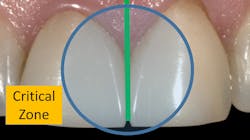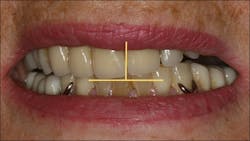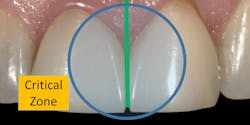Setting up a symmetrical smile: The anterior midline critical zone
We are often taught that smile design starts with the upper central incisors. To achieve an esthetically pleasing result, it is imperative that the maxillary central incisors be mirror images of each other. If they are not, the smile can look “off” or unesthetic. In fact, the closer we get to the physical midline of the smile, the more vital it is that bilateral symmetry be present. Differences in the central incisors will be more readily noticeable than discrepancies in the lateral incisors, for example.
The anterior midline critical zone is comprised of three elements that can be used as a checklist to help hone and systematize symmetry.1
Components of the anterior midline critical zone
No. 1: Horizontal and vertical cant
If the horizontal and vertical orientation of the central incisors is incorrect, the smile is irreparable and must be redone, as a cant will result. In figure 1,No. 2: Incisal embrasure
To help ensure that the incisal embrasure is positioned appropriately, it is recommended that a disk be used with the clinician performing adjustments while directly facing the patient, who is seated upright in the chair. Doing so will help prevent a parallax.
No. 3: Mesiofacial line angle
Facial line angles, both mesial and distal, result from the junction of buccal and interproximal surfaces. When photographed with a flash, the line angle will reflect light. The line angle can be moved or adjusted with either disks or burs. Modifying the facial line angles can also alter the preceded width of the tooth. The difficulty lies in clearly seeing the line angles during the procedure, especially if strong illumination is used as the area can become washed out.Clinical case
Two weeks before her wedding, a 32-year-old female came to the office unhappy with her smile, particularly her upper central incisors (figure 2). As she needed comprehensive periodontal treatment and there were time constrains, single-shade direct composite veneers were completed as a long-term provisional.
Related reading—
- Considerations when using veneers to fabricate a perfect smile
- Predictable esthetics using smile design and a balanced occlusion in centric relation
- When orthodontics falls short: Managing diastemas with porcelain veneers
Editor’s note: This article first appeared in Through the Loupes newsletter, a publication of the Endeavor Business Media Dental Group. Read more articles and subscribe to Through the Loupes.
Reference
- Volker AR. Mayorga K. The anterior midline critical zone: esthetic shape determinant. The GP. Fall 2020:GP 6-7.
About the Author
Arthur R. Volker, DDS
Arthur R. Volker, DDS, graduated from the Columbia University School of Dental and Oral Surgery. He is a diplomate of the World Congress of Minimally Invasive Dentistry and a fellow of the Academy of General Dentistry and the American College of Dentists. He is in private practice in New York, with an emphasis on digital and minimally invasive dentistry. Dr. Volker writes articles and lectures nationally and internationally on topics such as cosmetic dentistry, minimally invasive dentistry, dental materials, and dental implants.





